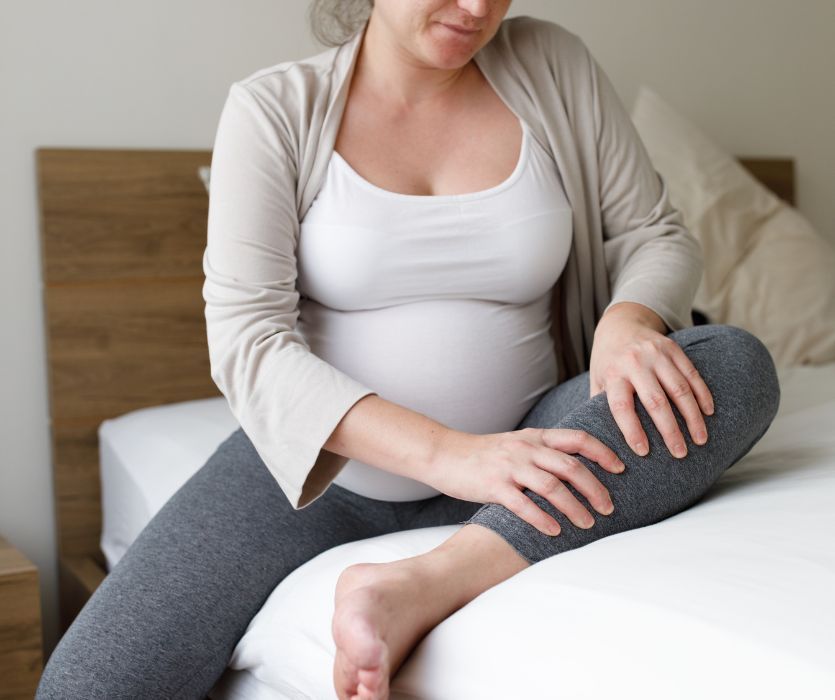As if things like nausea, exhaustion and non-stop peeing aren’t annoying enough during your pregnancy – there’s also something rather delightful that many pregnant women experience called Restless Leg Syndrome (RLS).
What is Restless Leg Syndrome?
RLS – or ‘the jimmy legs’ as I like to refer to it – can be described as a strong or uncontrollable urge to move your legs in order to relieve an unpleasant sensation. You may get a tingling or burning feeling in your calf, thigh or foot– or they might just feel uncomfortable. Some women even describe the feeling as similar to having a panic attack.
Fortunately, Restless Leg Syndrome is not dangerous or a sign that something is wrong. But these nocturnal leg cramps can disrupt your sleep – and that is definitely not enjoyable when you’re pregnant.
What causes it?
RLS typically peaks in the third trimester - around the 7th or 8th month of pregnancy, when estrogen levels are particularly high - and usually disappears altogether by the time you have your baby. It doesn’t seem like anyone really knows what causes it. But there are a number of theories about the possible culprits.
- Iron deficiency, folate deficiency and changes in hormones all have the potential to increase the prevalence of restless leg syndrome
- Caffeine can make symptoms worse so if you can handle it, you may want to try eliminating caffeine from your diet completely
- Poor blood circulation
- Not enough movement during the day
- Lying down while reading or watching television at bedtime can make things worse – so basically, don’t do anything enjoyable and you’ll be fine
There aren’t any official tests to diagnose it, but your doctor may have your iron levels checked.
Treatment of restless legs syndrome
Pregnant women who have dealt with RLS have laid out some guidelines to help ease discomfort including:
- Walking (even just around the house)
- Stretching and yoga
- Warm baths
- Massages and leg rubs
- Rinsing your legs and feet in cool water before bed (not a full bath, just rinsing the feet)
- Some women keep a food journal to see if something they eat (typically later in the day) is triggering the jumpy legs at night
- Amping up iron-rich foods like spinach, beans and whole-grain bread in your diet
- You could ask your doctor or midwife if you might need an iron supplement or tweak to your prenatal vitamins– or possibly magnesium supplements, vitamin B12, vitamin C, vitamin D, or folate
- Try avoiding caffeine to see if it helps you get a better night’s sleep
- Certain medications might make symptoms of RLS worse, such as some antidepressants or drugs that inhibit dopamine, like anti-nausea medication
- Elevating your legs above your heart for around 20 minutes each day
- There is even a foot wrap treatment that applies pressure to your feet and apparently signals your brain to relax your muscles. Sounds interesting, but you need a prescription and the foot wraps are pretty pricey, so you may want to try out compression socks first. Although it couldn’t hurt to ask your medical practitioner.
Some people even swear by home remedies like eating bananas or sleeping with a bar of soap under the covers by their feet. Hey – if you’re willing to try anything, why not? Having had it myself, I know how uncomfortable and annoying RLS is. I personally found that adding a giant pregnancy body pillow between my legs as part of my sleep routine was the best way for me to get comfortable.
The good news is – it doesn’t often last very long. And with a few of these tips, you’ll hopefully be able to manage it until your weeble arrives and the RLS symptoms subside.
To sum up RLS
Restless Leg Syndrome, also known as Willis-Ekbom Disease, can be a real pain in the - er, legs - but if you’re suffering from it, you’re definitely not alone. Over 9 million people in the US are living with moderate to severe symptoms of RLS.
While there isn’t a cure out there yet, simple lifestyle changes like stretching, walking more, massaging the muscles in your legs, avoiding stimulants like caffeine and adopting healthy sleep habits can bring at least some relief.
Other remedies, such as wearing compression socks or prescribed foot wraps, and taking medications and supplements can also help to treat Restless Leg Syndrome.
Did you have Restless Leg Syndrome During Pregnancy?
Did anything work for you? I’d love to know!
Our next reco: The End of Pregnancy is the Worst




Leave a Comment